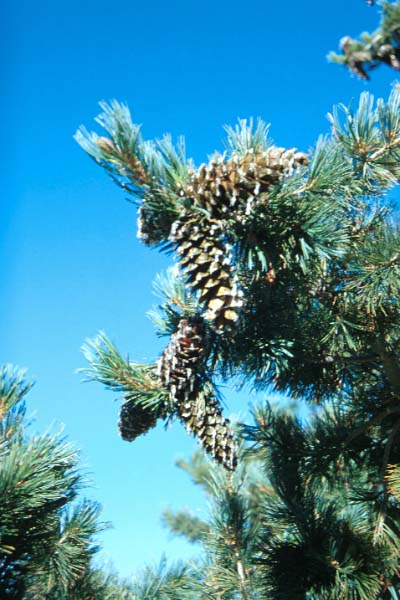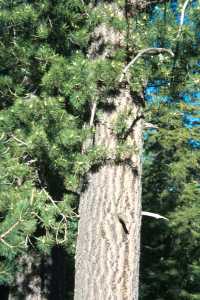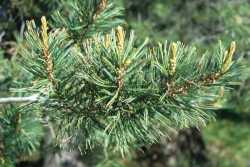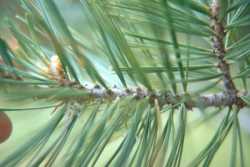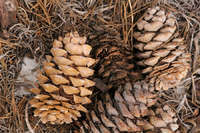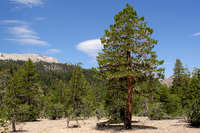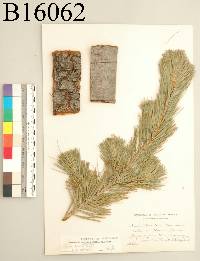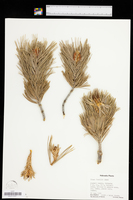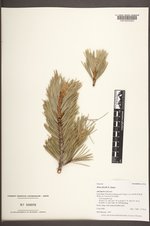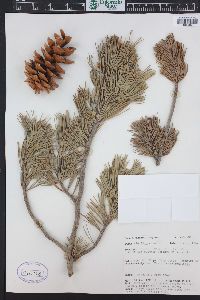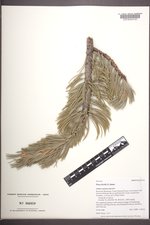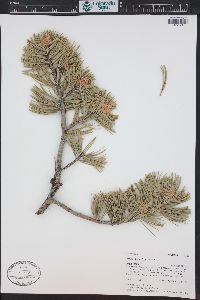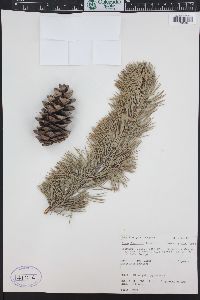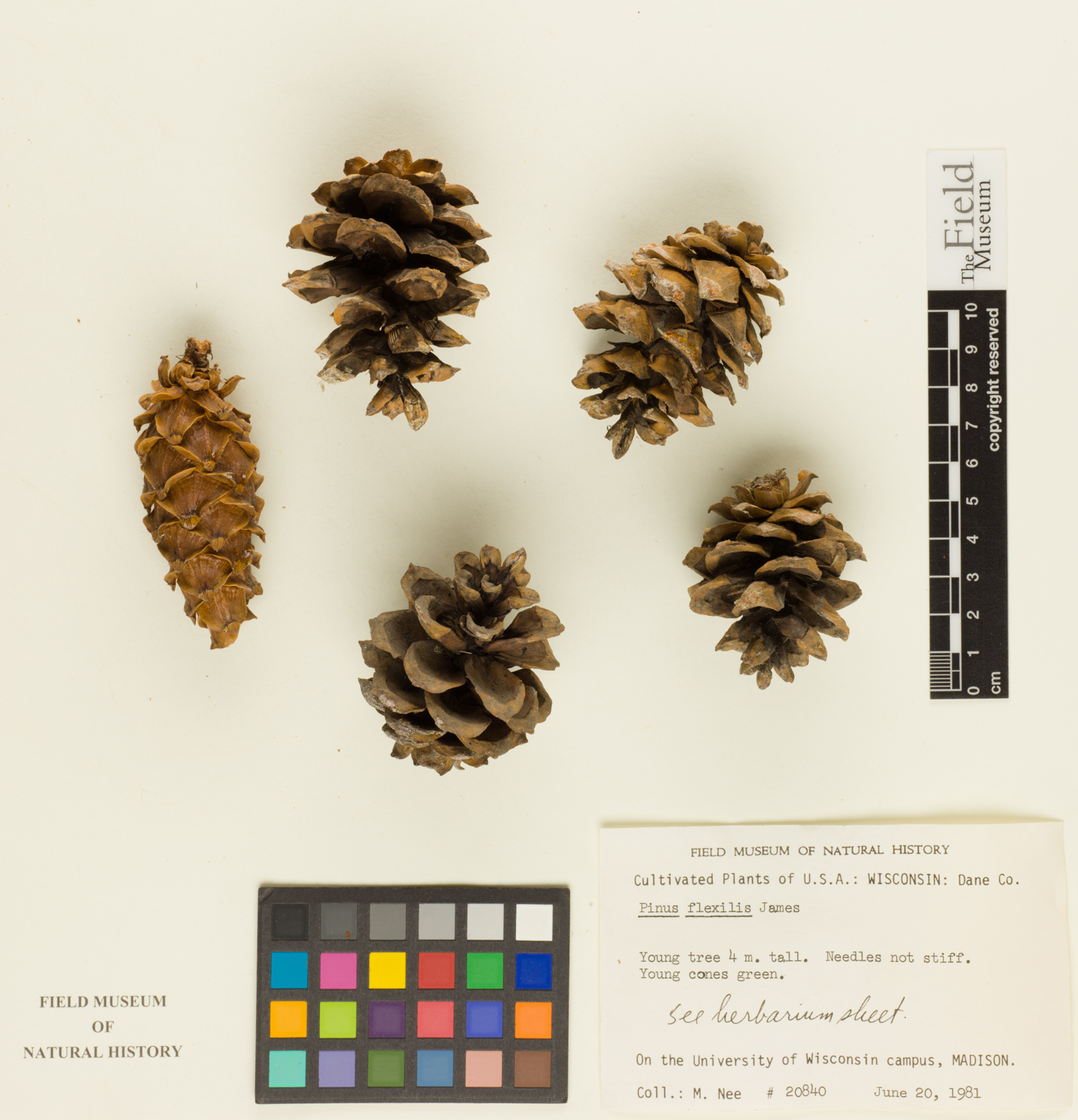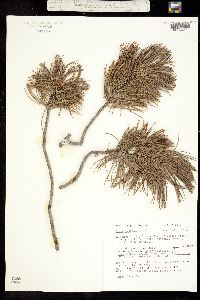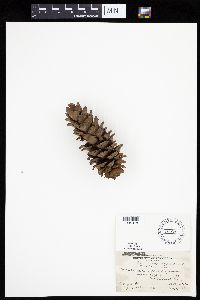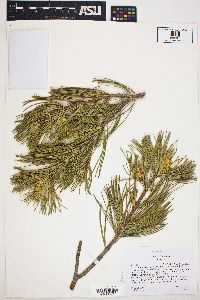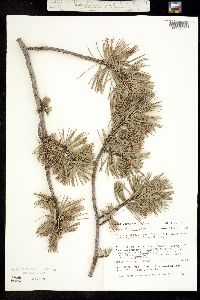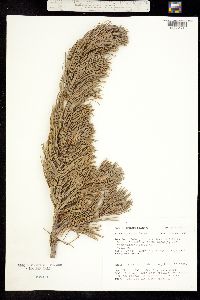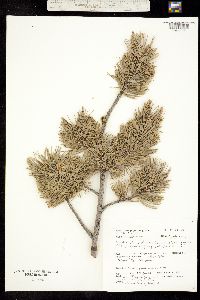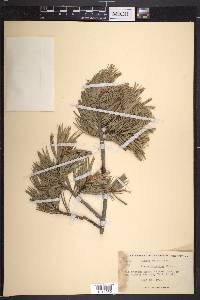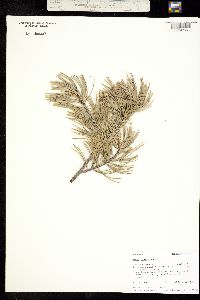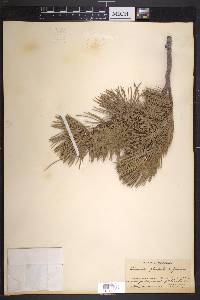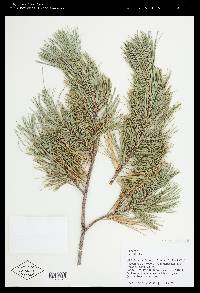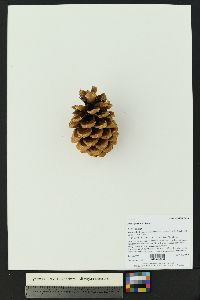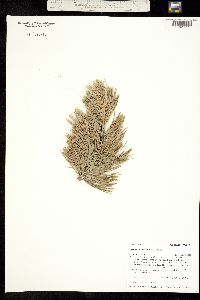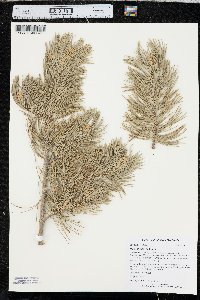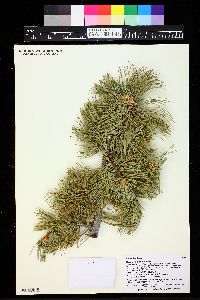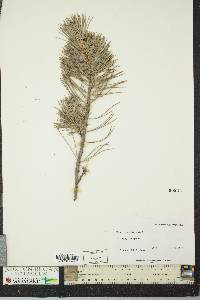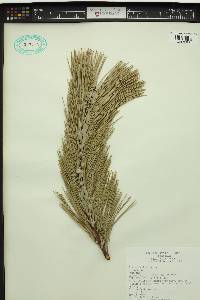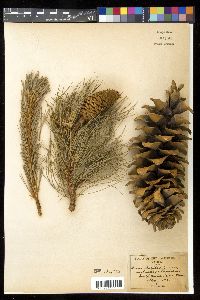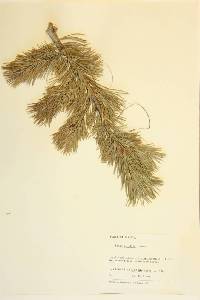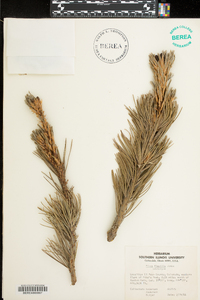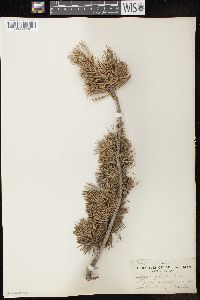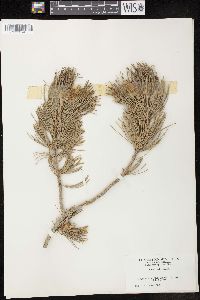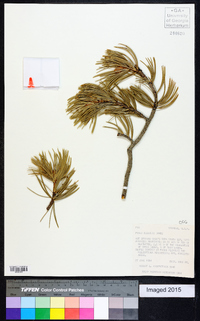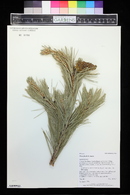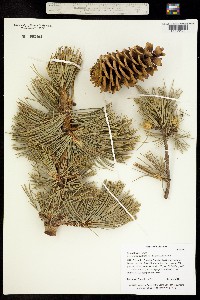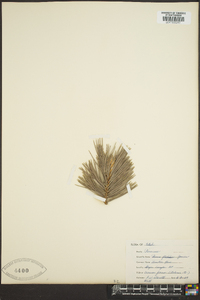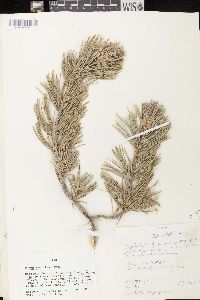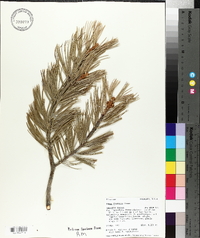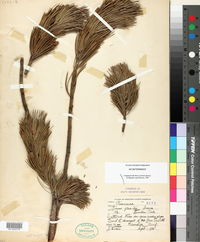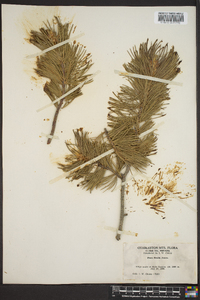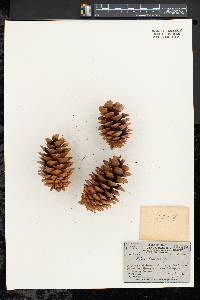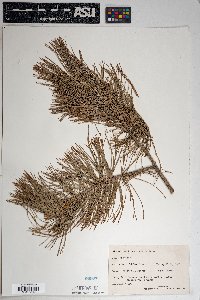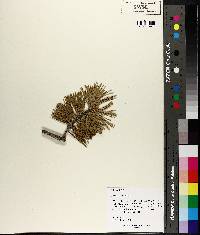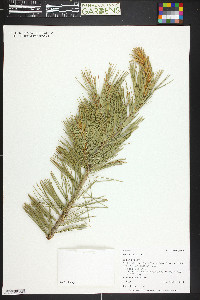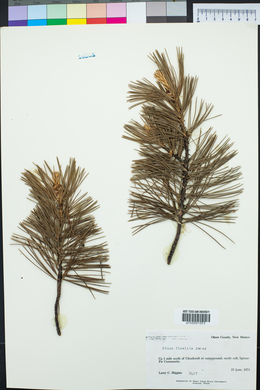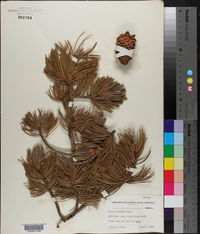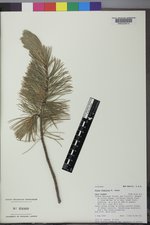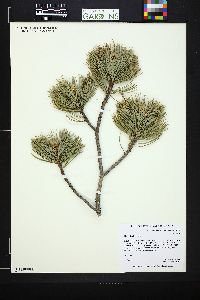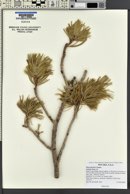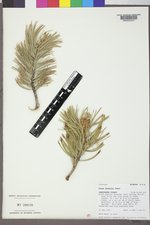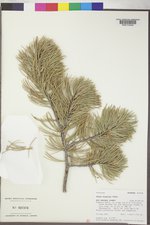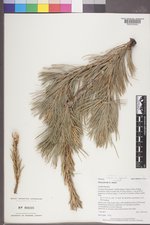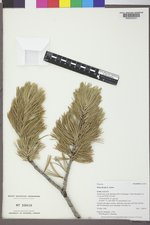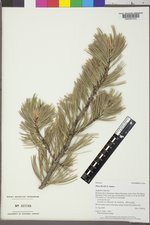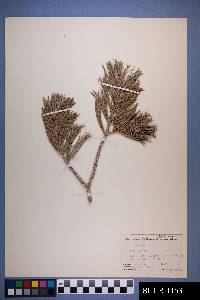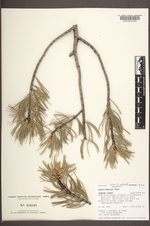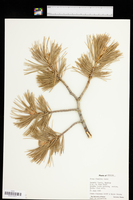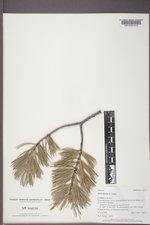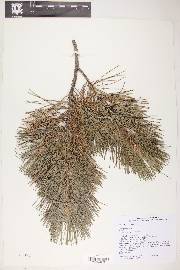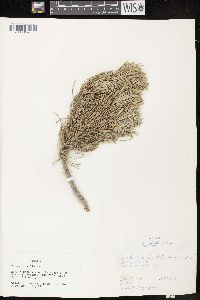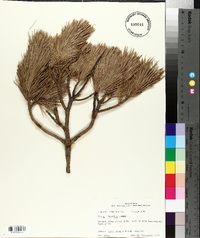
|
|
|
|
Family: Pinaceae
Limber Pine, more...rocky mountain white pine
[Apinus flexilis (James) Rydb.] |
Trees to 26m; trunk to 2m diam., straight to contorted; crown conic, becoming rounded. Bark gray, nearly smooth, cross-checked in age into scaly plates and ridges. Branches spreading to ascending, often persistent to trunk base; twigs pale red-brown, puberulous (rarely glabrous), slightly resinous, aging gray, smooth. Buds ovoid, light red-brown, 0.9--1cm, resinous; lower scales ciliolate along margins. Leaves 5 per fascicle, spreading to upcurved and ascending, persisting 5--6 years, 3--7cm ´ 1--1.5mm, pliant, dark green, abaxial surface with less conspicuous stomatal bands than adaxial surfaces, adaxial surfaces with strong, pale stomatal bands, margins finely serrulate, apex conic-acute to acuminate; sheath 1--1.5(--2)cm, shed early. Pollen cones broadly ellipsoid-cylindric, ca. 15mm, pale red or yellow. Seed cones maturing in 2 years, shedding seeds and falling soon thereafter, spreading, symmetric, lance-ovoid before opening, cylindro-ovoid when open, 7--15cm, straw-colored, resinous, sessile to short-stalked, apophyses much thickened, strongly cross-keeled, umbo terminal, depressed. Seeds irregularly obovoid; body 10--15mm, brown, sometimes mottled darker, wingless or nearly so. 2 n =24. High montane forests, often at timberline; (1000--)1500--3600m; Alta., B.C.; Ariz., Calif., Colo., Idaho, Mont., Nebr., Nev., N.Mex., N.Dak., Oreg., S.Dak., Utah, Wyo. Pinus flexilis , much branched with a strongly tapering trunk, is little utilized because of its form and relative inaccessibility. It reportedly forms intermediates with P . strobiformis where the two overlap. The fresh-cut wood has the odor of turpentine.
Common Name: limber pine Duration: Perennial Nativity: Native Lifeform: Tree General: Evergreen tree, 8-20 m (26-65 ft) tall, shrubby (krummholz) in exposed habitats at high elevations; trunk up to 2 m in diameter; crown pyramidal, becoming rounded with maturity; branches spreading to ascending, usually persisting to near trunk base; twigs slender, flexible, gray to pale red-brown, puberulent, soon becoming glabrous; buds ovoid, 0.9-1 cm long, reddish brown. Light gray or silvery white, smooth on young trees; dark brown to grayish, furrowed into broad, rectangular, scaly plates on mature trees. Needles: Needles, 5 per fascicle, 3-7 cm long, spreading to upcurved, slender, flexible, dark green with fine, white stomatal lines on all surfaces. Cones: Male and female cones on same tree; male (pollen) cones ellipsoid-cylindric, 7-10 mm long, yellowish or reddish; female (seed) cones ovoid to somewhat cylindric, 7-15 cm long, yellowish to light brown, resinous, the scales thickened at the apex, unarmed, not recurved; seeds irregularly obovoid, 9-12 mm long, brown, wingless. Ecology: Montane forests, rocky slopes, common near timberline, mixed with aspen, spruce, fir, and pine, also found to a lesser extent in lower-elevation, ponderosa pine- dominated forests; 1500-3600 m (4900-12000 ft). Notes: Pinus strobiformis is similar to P. flexilis (and the two are reported to hybridize), but it has white stomatal lines only on the adaxial (inner) surface of the needles, and the seed cone scales have recurved tips. Often growing on nutrient-poor sites on exposed ridges and summits, P. flexilis is a slow-growing and long-lived species that may take hundreds of years to reach maturity, attaining a lifespan of more than 1000 years. Cold stratification improves germination. It has high drought tolerance. The thin bark on younger trees provides little to no protection from low-intensity fire, but the thicker bark on mature trees provides protection against such fires. Limber pine is highly susceptible to fungal diseases. It has low browse and forage potential. Clark's nutcrackers are the primary harvesters and dispersers of seed. Seeds are often stored in caches, providing food for rodents, birds, and bears. Limber pine has few medicinal uses, but the seeds are edible. The wood also has limited commercial use, but may be used for railroad ties. Synonyms: Apinus flexilis |
This project was made possible in part by the Institute of Museum and Library Services [MG-70-19-0057-19].
Powered by Symbiota

